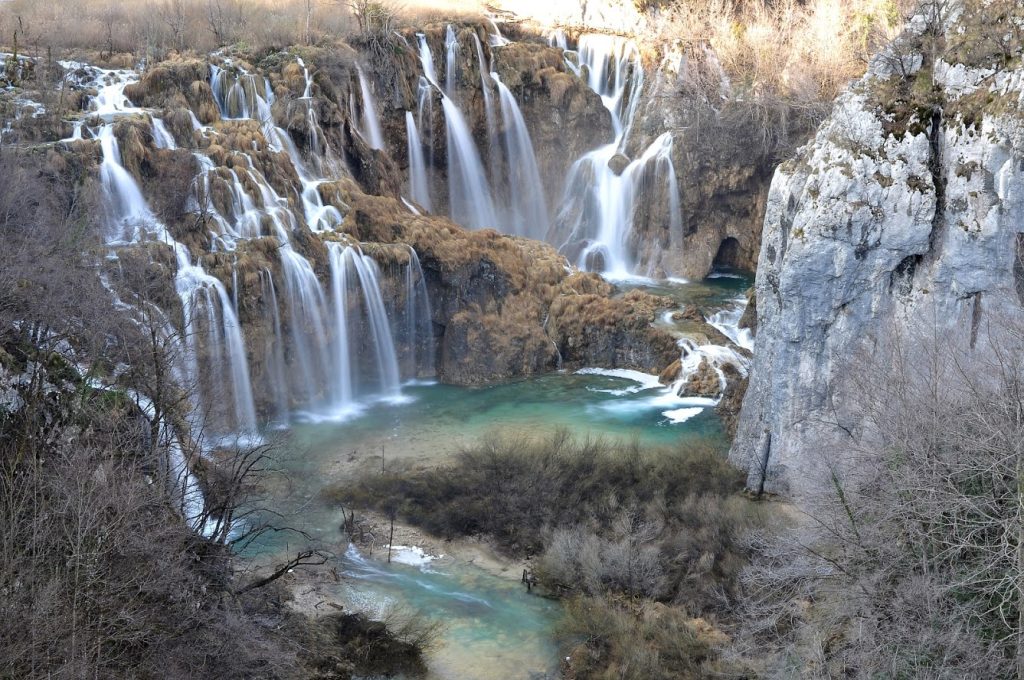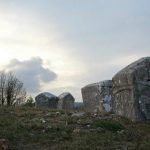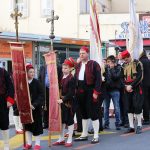April 13, 2020 – Continuing her look at the UNESCO treasures of Croatia, Filipa Marusic enjoys some blissful self-isolation at Plitvice Lakes National Park.
This article will take a look into probably the best-known UNESCO World Heritage from Croatia – Plitvice Lakes. Plitvice Lakes is the oldest and largest National Park in Croatia. Its location is between Mala Kapela mountain in the west and northwest and Lička Plješivica mountain in the southeast. It is covering two counties – Lika-Senj county 90.7% surface and Karlovac county 9.3% surface, and the total park surface is 29 630,77 ha. The Plitvice Lakes became a national park on April 8th, 1949, and was inscribed to UNESCO World Heritage List on October 26th, 1979, due to its outstanding universal value. Its outstanding universal value lies in the travertine (tufa) formation process, which, as a result, has travertine barriers and created the lakes, caves, and waterfalls in the Park.
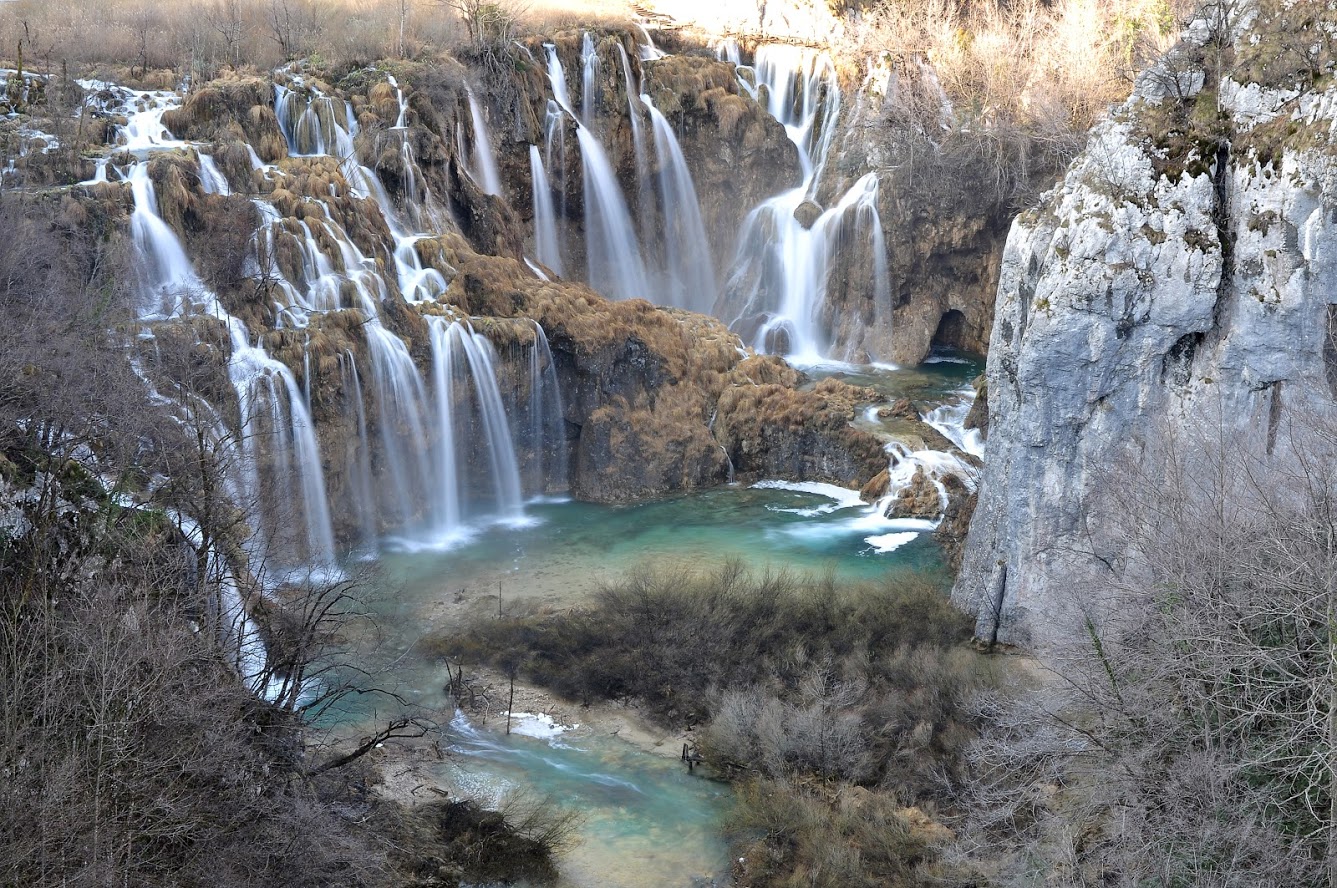
The national Park is mostly forest, and the lakes cover just under 1% of the total park area. Forests are the home many rare and endangered species. There is a total of 16 lakes that cascade one into another. Lakes are divided into Upper and Lower lakes based on their geological structure and hydrogeological conditions. Twelve lakes form the Upper Lakes: Prošćansko Lake, Ciginovac, Okrugljak, Batinovac, Veliko jezero, Malo jezero, Vir, Galovac, Milino jezero, Gradinsko jezero, Burgeti, and Kozjak. These lakes have a base of dolomite rock. They are larger than the Lower Lakes and have a rugged shore. Four lakes form the Lower Lakes: Milanovac, Gavanovac, Kaluđerovac, and Novakovića Brod. The Lower lakes were created in the narrow limestone canyon, and they have a steep shore. These lakes end with the Sastavci waterfalls where the Korana River springs under the base of falls. The biggest lake is Kozjak, followed by Prošćansko lake. The origin of these lakes goes back to about 12000 to 15000 years ago.
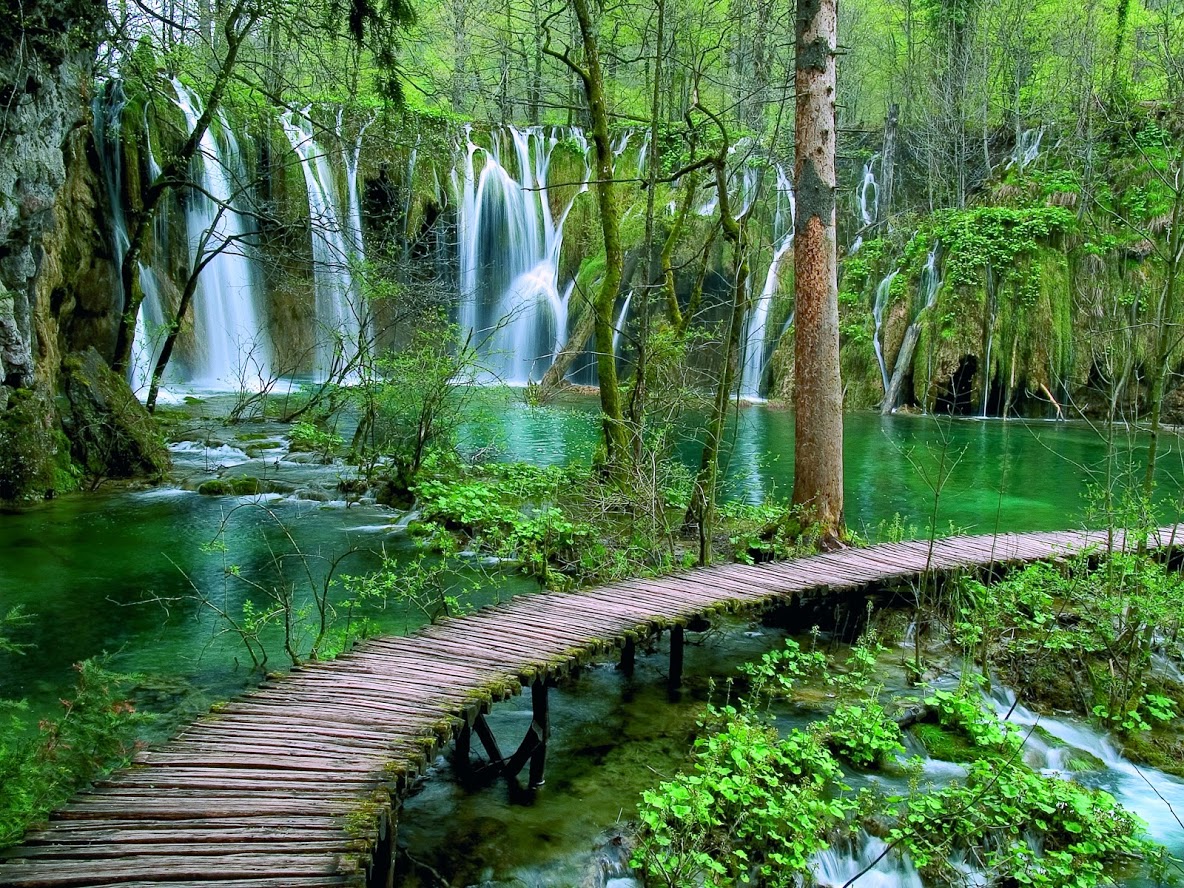
The Plitvice Lakes are part of the Dinarides karst region, and it is one of the most significant karst landscapes in the world. This kind of landscape is primarily made up of carbonate rocks such as limestone and dolomite rocks, which are sensitive to chemical and mechanical influences, as well as the influence of tectonics. The water with carbon dioxide goes through cracks in carbonate rock, and it leaves its trace in the rock and makes different karst forms on the land surface and underground, such as funnels, depressions, karst fields, towers, columns, caves, and pits. There are 114 speleological structures in the Park, out of which are 72% pits and 28% caves. Most of the structures are smaller, and the total length of all structures is 1664 m, and the overall depth is 2251 meters. Most of the water surface is cascading into 16 lakes of different sizes, which are created by the biodynamic process of travertine barriers. Water covers less than 1% of the territory of the park, and this makes 22.95 million cubic meters of water. As the travertine barriers grow, the water levels rise and increase the volume of water in the lakes. The lakes have connecting waterfalls between the lakes.
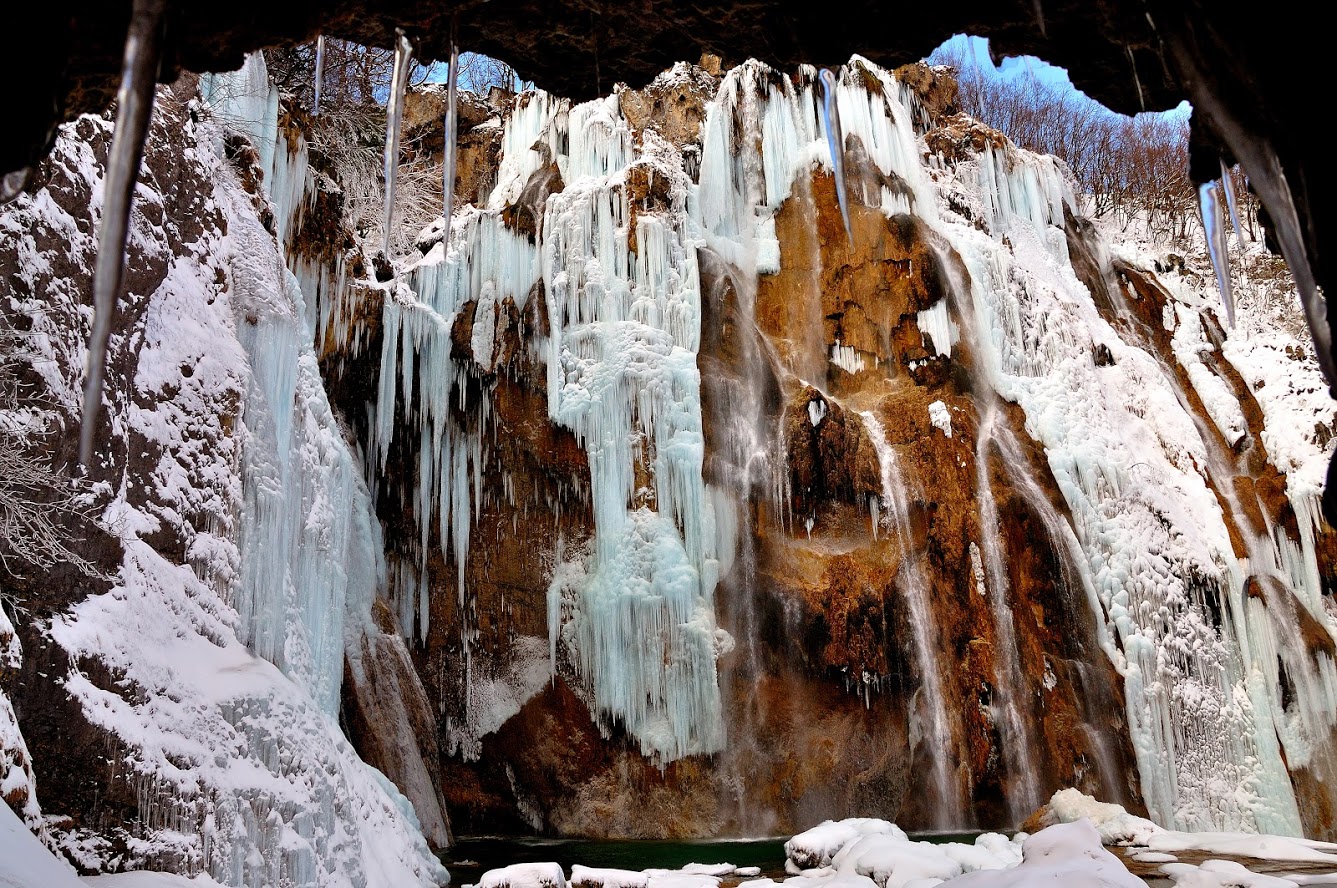
Travertine barriers formation
The travertine barriers have an ongoing growing process, and the biodynamic structures are changing all the time, and it changes the appearance of the lakes and the waterfalls. Travertine or tufa, by definition, is “Tufa is a hollow, porous rock created from the deposition of dissolved calcium carbonate in the water by plants, algae, and mosses.” The second definition is: “Tufa is a product of calcium carbonate deposited at temperature conditions near to the ambient temperature, and often contains the remnants of microphytes and macrophytes, invertebrates and bacteria.”
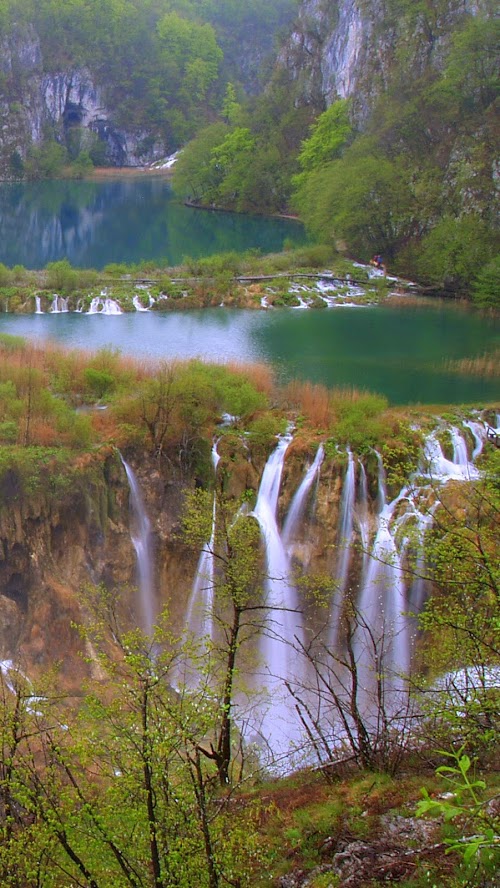
The water of the Plitvice lakes is over-saturated with dissolved calcium carbonate in the form of calcium bicarbonate. At the travertine barriers, calcium carbonate is extracted from the mineralised water in from crystals, which accumulate on the surface. The travertine forming process is dependent on specific algae, various bacteria, protozoan, and other microscopic organisms. These organisms are a living community developed on rocks, plants, mosses, and objects immersed in water. The calcite microcrystals adhere to the algae and bacteria secreting substances. These bonded crystals represent crystallisation sites around which calcium carbonate will continue to accumulate, and it will form travertine barriers. The moss and other micro and macrophytes are common around travertine barriers. The moss is quite common – some become petrifies in tufa making process, and some continue to grow. The travertine forming process goes back to the geological part during periods with a warm and humid climate, which is similar to climate nowadays. The age of the active travertine barriers is estimated between 6000 and 7000 years, which corresponds to the theory the tufa began its process following the end of the ice age. In the flanks of today’s streams and sources of lakes, there were paleobarriers of higher altitude and older age. Analyse dated the age of 250 000 – 300 000 years (Midel-Riss interglacial) and 90 000 – 300 000 (Riss-Wurm interglacial).
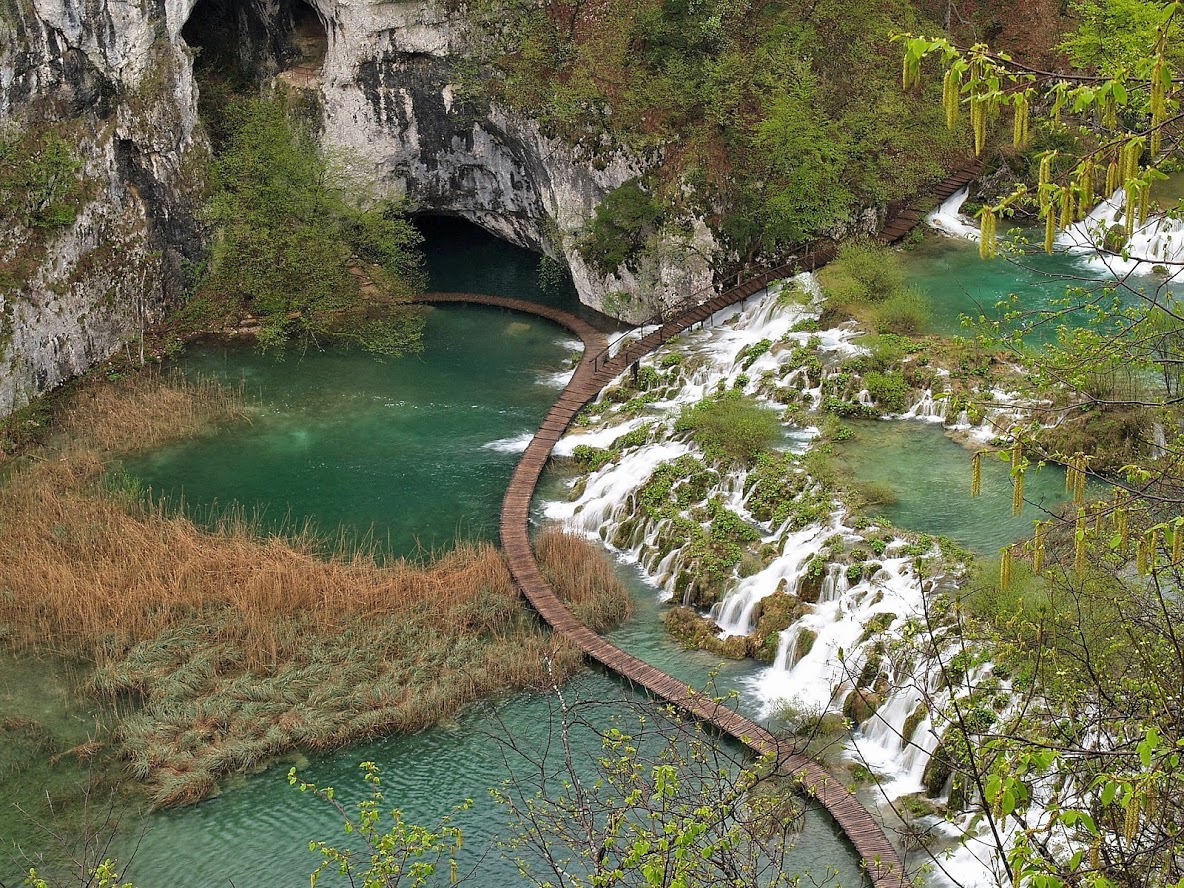
Analysis of the age of the active barriers and lake sediments show the average annual deposition rate of lake sediment is about 17 times slower than the speed of travertine barriers growth (about 13.5 mm) – this increases water level. Each lake barrier has its growth dynamic, and some grow faster another slower. Sometimes the downstream barriers grow faster than the upstream obstacles, and this way, they submerge the upstream barrier and two lakes from one lake. For example, on the location of Kozjak lake, there were 400 years ago two lakes and were separated by travertine barrier and 40 m high waterfall. The travertine barrier at the end of Kozjak lake grew faster than the barrier separating it. This way, the water level raised, the lake level increased and covered the waterfall, and the barrier and merged two lakes into one. This process created the lake as we see it today – lake Kozjak the biggest lake of the Plitvice lakes. The travertine barrier growth is affected by changes in physicochemical and biological factors that are important in the travertine growth process. It can be damaged with mechanical processes and is affected by water flow. This way, travertine barriers stop growing or can break if trees fall or ice melts after winter.
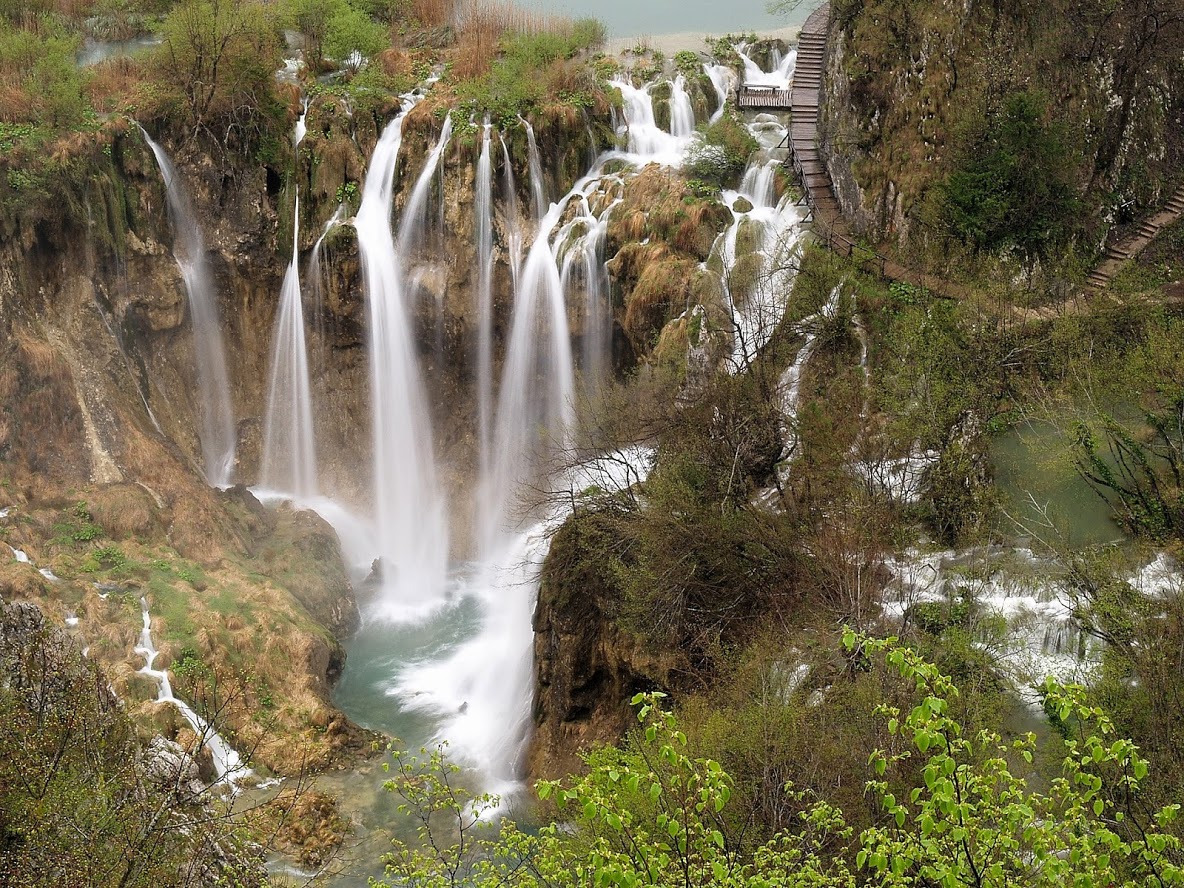
Biodiversity of Plitvice Lakes
The Plitvice Lakes national park has rich flora and fauna. The fauna is diverse due to the preservation of natural habitats, but biological diversity researched is not entirely researched. There are 259 species of vertebrates about which we have enough information, while numerous invertebrate species are not sufficiently studied except for the limnological researches in aquatic habitats. From the all researched species, there is a significant number of rare and endangered species that are included in different flora protection directives and conventions. All these species are evidence of the diversity and specific natural surroundings of the Park area. In the insect group, there are various species, and just in the butterfly group, there are 321 different species. There are only 321 of butterflies. Several butterfly species are listed as endangered. Other insects include caddisflies, dragonflies and other, out of which some are endangered, and they show the connection between water and land ecosystems and are essential bioindicators. In the water ecosystem, there are several crayfish endangered species as well as various fish species even though the fish structure changed during years. There are 14 species of each amphibian and reptiles – there are six protected amphibians, and ten protected reptile species of them are protected. The Park has 168 bird species. Bird species include woodpeckers, owls, gazebos, and birds of prey, which are proof of the excellent quality of forest habitats – there is about 76% of Park area covered in forest. Grasslands and lawns cover 23% of the Park area and are habitats and nesting locations for several bird species. There is a total of 37 endangered bird species and 76 protected bird species. There are 50 mammal species out of which 22 protected bat species. There are large carnivores like brown bear, grey wolf, lynx, and otter, which are all protected and endangered species and show quality and conservation level of the natural environment in the Park. These species look for secluded areas where there is enough prey, shelters for rest, and upbringing the cubs. There is an indigenous breed in the park area – Lika Pramenka sheep – the total population of this sheep species, is around 400 heads. This sheep herd is found in the mountain regions on natural pastures rich in vegetation but under harsh winter conditions. This breed is adaptive and resistant and gives meat and milk.
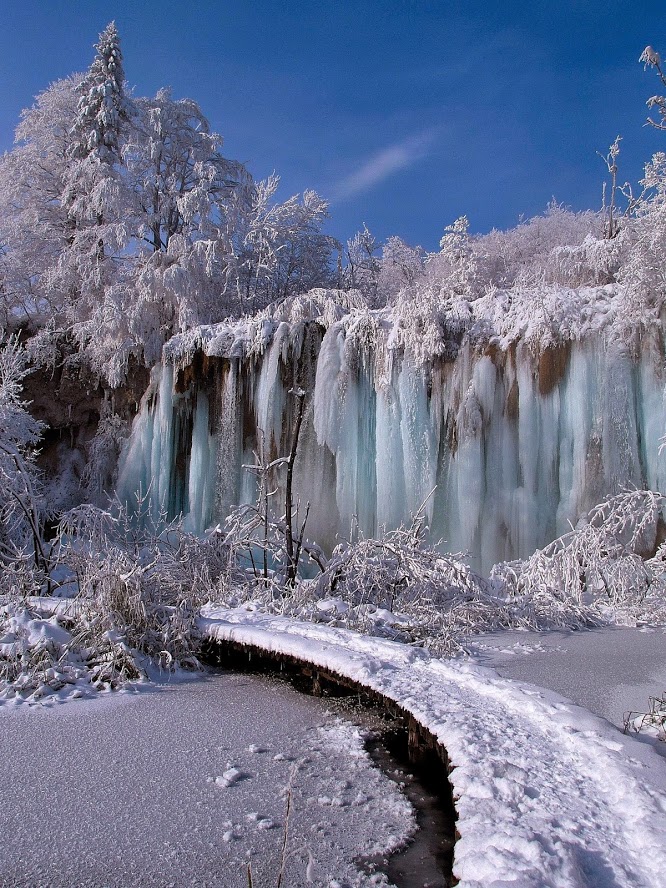
At the moment, there are more than 1400 species and subspecies of plants, and they equal to 30% of the entire Croatian flora. The diversity of plants is due to a specific geographic location. Plitvice Lakes is located just 55 km air distance from the sea and in the inland of Velebit mountain and on slopes of Mala Kapela and Lička Plješevica at an altitude of 369 – 1279 m. This area has different geomorphological, climatological, and ecological factors. In the relatively small park area, there are plants from different areas ranging from the Mediterranean, Mediterranean-Atlantic, Illyrian, Balkan, Carpathian, Eurasian, Circulatory, Boreal, and others. The number of endemic plant species is just 1,7%, but there is 4,64% of endangered plant species. There are 60 species of orchids and three species of carnivorous plants. The park has plenty of fungi and lichens, which have a role in the functioning of terrestrial ecosystems. There are more than 800 fungi species in the Park.
Grasslands habitats (meadows and pastures) are essential for the diversity of flora and fauna in the Park. In the past, people needed these spaces for livestock and food. In this way, they increased the biodiversity and the stability of the ecosystem by practicing a traditional way of life. As fewer and fewer people live in the area and the traditional way of life is abandoned, there is a potential problem in the survival of grassland and heaths flora. Heaths are also in the park area and represent grasslands developed in relatively dry habitats. The Park has bog habitats too – they date back to the glacial period – these are small areas highly dependent on microclimate conditions. Underground habitats and species living there are not sufficiently researched and are under constant threat from visitors, illegal waste disposal, and polluting water.
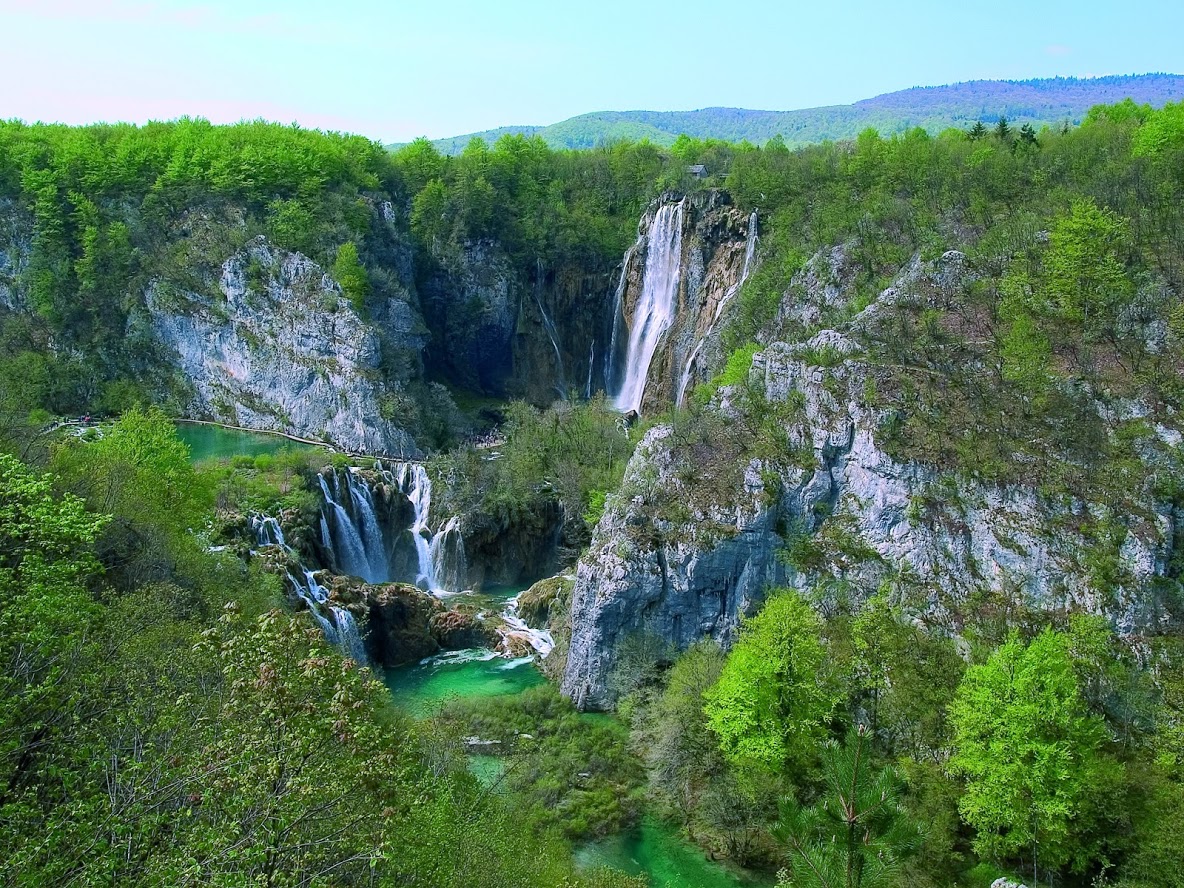
The location of Plitvice Lakes National park gives the area a moderately warm and humid climate. The vegetation is defined by altitude, terrain characteristics, but also geological background, soil type, and way of using it. The geological base is limestone and dolomitic rocks. Forests cover ¾ of the park area and are ranging from shrubs to rainforests. There are different forest zones – there is a predominant beech forest zone and beech-fir zone. There is also azonal vegetation like willow, black alder, black hornbeam, common pine, spruce forest. As part of the beech forest, there is a rocks community developed on stone blocks. There are several forest communities within the park area. They include alpine beech forest, beech-fir forest, common beech, and hellebore forest, spruce forest with hellebore, silver pine forest with black hellebore, hop hornbeam with winter heather, hop hornbeam forest and thicket with autumn moor-grass. The forests are habitats for already mentioned forest flora and home for wildlife species. They have an essential role in preventing soil erosion and affect climate and hydrological conditions as well as contribute production of oxygen and storing carbon.
The biodiversity of the aquatic ecosystem is valuable for the Park, and there are three different habitats in aquatic ecosystems. The species living the water need good water quality, and their presence indicates the quality of water and conservation of these habitats. Wetlands also represent essential habitat in the Park.
History and culture of the area
Plitvice Lakes and the surrounding areas stand as proof of human presence since prehistoric times. The area is rich in water, forests, flora, and fauna, as in natural shelters that allowed humans to live in this area. The area is between routes and roads from continental to the Adriatic region. First inhabitants from prehistoric times were Iapodes, from 12th to 1st century BC, when Romans started to rule the area but lived in cohabitation with Iapodes. In the medieval times, Croatian settlers mixed with Romanised Iapodes. There is also heritage in the form of medieval fortresses and churches. By the end of the 14th century, this area suffered from Ottoman invasions and was the location of constant warfare. After Ottomans, the Vlachs settled in the area. This area represented a border zone with the Hapsburg Monarchy, where there were ongoing conflicts. At the end of the 17th century, Lika was free from Ottoman rule, and this became the Military Frontier (Vojna Krajina). When Vojna Krajina came to an end in the 19th century, there were no more military conflicts in the area. Although there are a lot of different archaeological localities, they aren’t systematically researched or used in tourism purposes. The best-explored example is Krčingrad grad located on the peninsula between Kozjak lake and Gradinsko lake, where the was evidence of external defensive walls and two towers – one rectangular and large triangular.
Plitvice Lakes had the first accommodation facility in 1862 on Velika Poljana. After that, private accommodation facilities opened. Finally, the first hotel was built in 1896 called Hotel Plitvice, which got destroyed in a fire in 1939. By the end of the 19th century, there were also several roads connecting Plitvice lakes with the area. The beginning of 20th-century infrastructure was built too in the form of mills, sawmills, small hydropower plants, and various inns. Two world wars stopped any development of the area, and these old buildings don’t exist nowadays. After the Second World War, the area started new development, and it was proclaimed a national park in 1949.
As any protected area, this area also needs to find a balance between natural processes in the area and infrastructure for visitors. The buildings in the Park should be adapted to the surroundings and shouldn’t stand out. The example of this kind of building is Kozjak restaurant from 1949. which adapted to the national park area, and it is now a protected cultural structure. New hotel Plitvice from 1958 also was designed to fit into the forest environment. It is still in use and is a protected cultural building. In 1954 there were three forest lodges built as well as houses for accommodation for park staff. In the same area, there were several facilities to make it the administrative and tourist centre of Plitvice Lakes.
In the village Korana, along the northern border of the Plitvice lakes, there is a water mill and sawmill. In essence, these are rare examples of preserved traditional construction and the use of energy potential of the water. There was a hydropower plant on Burget lake, but it is not in use anymore. In several settlements in the Plitvice lakes national park, it is possible to see an example of the traditional architecture and way of life. The best examples are in villages Korana, Gornji Babin Potok, Donji Babin Potok, and Vrelo Koreničko. The residents mostly work in agriculture and tourism, and when you visit, you can buy homemade products. These are also protected cultural landscape of the Plitvice lakes national park.
Scientific development
The scientific and natural value can is visible in the fact that there is an almost 170-year long tradition of scientific research in the area. The first studies started in 1850 with the primary limnological depth measure and geological research. In 1893 the Society for the beautification of Plitvice Lakes and its surroundings was established, and it allowed research to continue.
The best-known researcher of the Plitvice lakes is Dr. Ivo Pevalek, who was the one to discover the aquatic mosses and algae were key factors for the formation of the unique geomorphology. He presented the fundamental phenomenon of the creation of travertine barriers. He was one of the strongest supporters of the decision to proclaim the Plitvice lakes national park. Before the area became national Park, the researchers worked as individuals and were self-funded. After the area became National Park, there was space for multidisciplinary studies and financial support by the national park administration. The vital contribution to Plitvice lakes research dates back to 1961 when the Plitvice Lakes got its biological station. The work here was continued in Ivo Pevalek scientific station opened 1975. These scientific stations had an essential role in initiating, intensifying, and coordinating scientific research and preparation for documents for the inscription of the Plitvice lakes on the UNESCO World Heritage List. The national Park published around this time the first issue of the Plitvice bulletin, which is the publication, which informs the expert public on the results of scientific research. There are also several scientific publications and organises scientific symposiums. During the Homeland war, the scientific work was interrupted. Still, in years after the war, there were numerous projects, and the work of scientific station is continuing in new Dr. Ivo Pevalek Scientific Research Centre. There are several ongoing water ecology projects as well as monitoring projects related to water and geology.
Visiting the lakes
The Plitvice Lakes National Park offers visitors seven different routes to tour the lakes and four hiking trails. The Park is open year-round, and all visitors must follow the instructions listed on the information board and keep to the marked trails and avoid leaving trash behind them. Some behaviour is not allowed in the National Park, and there are recommendations on how to prepare for the visit.
Strictly forbidden:
- Picking the plants or taking any “souvenirs” of natural origin
- Feeding the animals
- Swimming in the lakes
- Throwing away the waste along the trails or elsewhere, except in the garbage bins
- Drift away from the marked trails
Highly recommended
- Wear appropriate clothing and footwear
- Bring adequate rain and sun protection (umbrella, raincoat, sunglasses, hat, sunscreen – depending on the season)
- Check the weather forecast before coming to the Park
- Be sure to check the information listed on the website about the length of specific trails, to ensure that you have enough time to complete the desired tour
- During your stay in nature, keep food and drink in closed containers and do not leave the food and other waste in nature
- Throw away the garbage at the designated disposal site
- Before eating wash your hands
- Do not touch the nests and other places you notice during your visit
To see all the visiting options check the web app with different suggested park routes which include hiking, boat ride and train.
SOURCE (Text and photos): UNESCO, Plitvice Lakes National Park – Arhiva Nacionalnog parka Plitvička jezera

